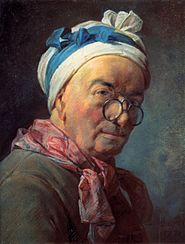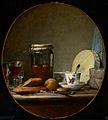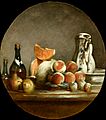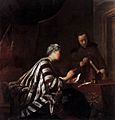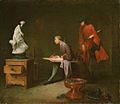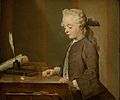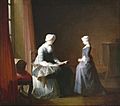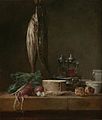Jean-Baptiste-Siméon Chardin facts for kids
Jean-Baptiste-Siméon Chardin (born November 2, 1699 – died December 6, 1779) was a famous French painter from the 1700s. He is known as a master of still life paintings. He also painted many "genre" pictures. These showed everyday scenes like kitchen maids, children, and home activities.
Chardin's paintings are special because of how he put them together. He used a careful balance in his pictures. He also made the light look soft and spread out. His paint often looked thick and textured, which is called impasto.
Contents
What is Still Life Painting?
Still life painting is a type of art. It shows objects that do not move. These can be things like fruit, flowers, food, or kitchen items. Chardin was very good at making these everyday objects look beautiful and real. He often painted simple things found in a home. He showed them in a way that made you notice their textures and shapes.
Chardin's Still Life Works
Chardin painted many different still life scenes. He often showed food like peaches, plums, or bread. He also painted kitchen tools, bottles, and jars. His paintings make these simple items seem important. He used light and shadow to give them a calm, quiet feeling.
What are Genre Paintings?
Genre paintings show scenes from everyday life. They are not about famous people or big historical events. Instead, they show ordinary people doing normal things. Chardin's genre paintings often featured children playing or learning. He also painted women working in the kitchen.
Chardin's Genre Scenes
Chardin's genre paintings are special because they show real life. He painted children blowing soap bubbles. He also showed them learning to draw. His paintings of kitchen maids are very famous. They show women busy with daily chores. These paintings give us a peek into homes from the 1700s. They show simple, honest moments.
Chardin's Painting Style
Chardin's style was very unique. He used a special way of painting called impasto. This means he applied paint thickly. You could often see the brushstrokes. This gave his paintings a rich texture. He also used light in a soft, gentle way. This made his paintings feel calm and peaceful. He focused on making things look real and true to life.
Images for kids
-
Jar of Apricots (1758), oil on canvas, 57 x 51 cm., Art Gallery of Ontario
-
The Sliced Melon (1760), oil on canvas, 57 x 52 cm., Louvre
-
Dead Rabbit and Hunting Gear (ca. 1727), oil on canvas., 81 x 65 cm., Louvre
-
The Ray (1727), oil on canvas, 114.5 x 146 cm., Louvre
-
Soap Bubbles (ca.1733-1734), oil on canvas, 93 x 74.6 cm., National Gallery of Art
-
The Draftsman (1737), oil on canvas, 80 x 65 cm., Louvre
-
The Return from the Market (1738–39), oil on canvas, 47 x 38 cm., Louvre
-
The Governess (1739), oil on canvas, 47 x 38 cm., National Gallery of Canada
-
Portrait of Auguste Gabriel Godefroy (1741), oil on canvas, 64.5 x 76.5 cm., São Paulo Museum of Art
-
Saying Grace (1744), oil on canvas, 50 x 38 cm., Hermitage Museum
-
The Attentive Nurse (1747), oil on canvas, 46.2 x 37 cm., National Gallery of Art
-
The Good Education (ca. 1753), oil on canvas, 43 x 47.3 cm., Museum of Fine Arts, Houston
-
La Brioche (1763), oil on canvas, 47 x 56 cm., Louvre
-
Basket of Plums (1765), oil on canvas, 32.4 x 41.9 cm., Chrysler Museum of Art
-
Still Life with Attributes of the Arts (1766), oil on canvas, 112 x 140.5 cm., Hermitage Museum
-
Basket of Peaches, with Walnuts, Knife and Glass of Wine (1768), oil on canvas, 32 x 39 cm., Louvre
See also
 In Spanish: Jean Siméon Chardin para niños
In Spanish: Jean Siméon Chardin para niños


